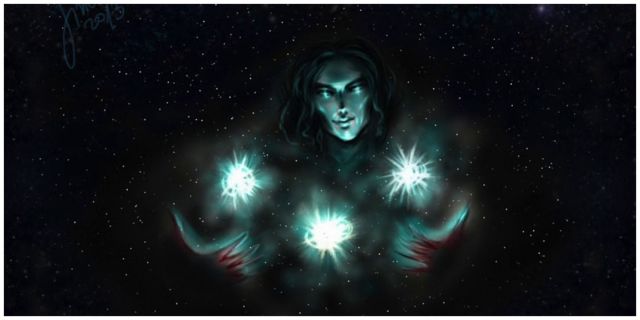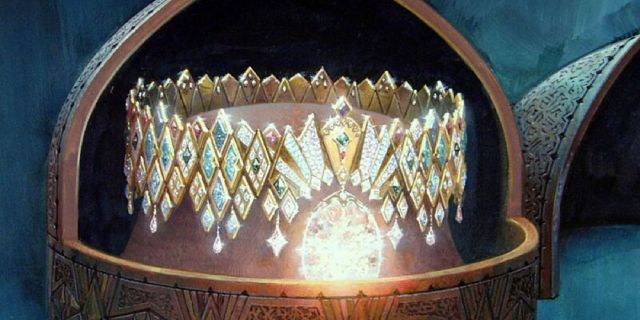Quick Links
- Where do the Silmarils Come From?
- What About the Nauglamír?
- The Nauglamír and the Silmarils
Many ages before the creation of the One Ring and the events of The Lord of the Rings, the lands of Middle-Earth were shaped in the pursuit of the many great artifacts. Among these was the Nauglamír, a magnificent necklace forged by the Dwarves of the First Age and gifted to the Elf Lord, Finrod.
Over the course of the necklace’s existence, it would eventually become inlaid with one of the three Silmarils, irreversibly changing its value and placing it at the forefront of some of the darkest deeds of the Elves of the First Age. Much like the One Ring’s corruption throughout The Lord of the Rings, the Silmarils’ great beauty seemed to ensnare their bearers, and the covetous love of the jewel placed within the Nauglamír would bring about great bloodshed between the races of Elves and Dwarves.
Where do the Silmarils Come From?

In order to understand the power of the avarice caused by the Silmarils, it is necessary to retrace the origins of the jewels. In the early years of Tolkien’s mythology, the Eldar Elves dwelt in Valinor, the home of the Valar in Arda. This hallowed land was illuminated by the radiant light of the Two Trees, Tulperion and Laurelin, which shone with the very brilliance of the Valar themselves. During this time, Fëanor, the greatest smith in the history of the world, crafted the three Silmarils, which captured the light of the Two Trees within their crystalline majesty.
The Silmarils were the pride of Fëanor and his house, and were desired greatly by the Dark Lord Melkor whilst he dwelt in Valinor as a secretive enemy. During a celebratory feast in Valinor, Melkor seized his opportunity and enlisted the aid of the great spider Ungoliant. Together, they destroyed the Two Trees, sucking the light from their roots and thrusting the land into darkness. In the ensuing chaos, Melkor slew Fëanor’s father, Finwë, and stole the Silmarils from the vaults of the Noldor. He fled back into Middle-Earth, thus beginning a hatred between the Elves and the Dark Lord that would result in countless lives lost in the pursuit of his defeat and the reclamation of the three jewels.
What About the Nauglamír?

Thousands of years after the theft of the Silmarils, Melkor’s (now called Morgoth) presence in Middle-Earth had become a vast power of darkness which dwelt in the northern fortress of Angband. From here, he wreaked havoc on the Elves of Beleriand, all while wearing the stolen Silmarils on an Iron Crown that rested atop his head. Among the Elves who resisted the powers of the Dark Lord, there was Finrod Felagund (Galadriels’s brother), who built the great Elven stronghold, Nargothrond.
Unlike most Elven fortresses, Nargothrond was notable for being built underground, much more akin to a Dwarven kingdom than anything else. The construction of it was in fact aided by the Dwarves of the Blue Mountains, who grew to greatly admire Finrod and value his leadership over the lands. When Nargothrond was completed, the Dwarves who helped Finrod also gifted him a great necklace, forged with jewels Finrod had brought from his time in Valinor. Thus, the Nauglamír was created, and its beauty represented kinship between the Elves and the Dwarves.
Unfortunately, peace in Nargothrond was not long to last. In 464 F.A, King Thingol of Doriath tasked Beren with claiming one of the Silmarils from Morgoth’s crown. Finrod elected to help Beren, and left Nargothrond in the care of Orodeth. The perilous quest would sadly lead to Finrod’s death, but a Silmaril would indeed end up in Thingol’s posession(albeit in the stomach of the werewolf Carcharoth). Eventually, the realm of Nargothrond would become the home of the tragic warrior, Túrin, who quickly became one of the greatest defenders of the land and a close ally of King Orodeth. Túrin encouraged the Elves of Nargothrond to openly defy Morgoth, and this inspired the Dark Lord to send the dragon Glaurung to destroy them. Glaurung laid waste to Nargothrond, and then settled in the abandoned city amidst a hoard of Elven treasure.
The Nauglamír and the Silmarils
Glaurung remained in Nargothrond for five more years, until he departed the stronghold to once again do battle with Túrin (a fight that would see the great dragon slain.) The halls were then occupied by the treacherous Dwarf Mîm, who wished to lay claim to the treasure therein. After several years, Húrin, the father of Túrin, would travel to Nargothrond after being forced to bear witness to the death of all of his children (including Túrin) while imprisoned by Morgoth. Húrin slew Mîm, and found the Nauglamír amidst the abandoned hoard of treasure.
Húrin brought the necklace to Thingol, as a gift to thank the Elven king for fostering Túrin and Húrin’s wife, Morwen. Thingol was still in posession of the Silmaril that had been taken from Morgoth’s crown, and his fondness of the jewel had grown exponentially over the years. He desired to carry the Silmaril on his person at all times, and thusly he enlisted the Dwarves of the Blue Mountains to inlay the Silmaril into the Nauglamír. The Dwarves greatly desired both the Silmaril and the necklace, but elected to help Thingol nonetheless.
When the reforged Nauglamír was finally completed, the Dwarves refused to hand it over to Thingol. They claimed that it had been made for Finrod alone, and that Thingol had no right to own such an artifact. Thingol perceived the greedy nature of their true intentions, however, and bade them to leave his kingdom. Instead, the Dwarves slew Thingol and absconded with the Nauglamír. This act of violence began the war between the Dwarves of the Blue Mountains and the Elves of Doriath, a source of tension that would fuel animosity between the races for thousands of years.
The Dwarves ransacked the halls of Meneroth in Doriath, and laid claim to all the treasure within. They were then waylaid by the interference of Beren and a host of Elves, who killed all the Dwarves. Beren took the Nauglamír, which still contained the Silmaril, and gave it to his love, Lúthien. Combined with her beauty, it was said that the sight of Lúthien and the jewels was the fairest sight east of Valinor. Following Lúthien’s final passing, the Nauglamír returned to Doriath. Having learned of the necklace and its location, the Sons of Fëanor soon demanded the Silmaril for themselves. With no answer from the Elves of Doriath, Fëanor’s sons attacked Doriath and committed the Second Kinslaying. Elwing, the princess of Doriath, managed to escape with the necklace about her neck, and with Fëanor’s sons in pursuit, she eventually threw herself into the sea, forever losing both the Nauglamír and the precious Silmaril within it.










